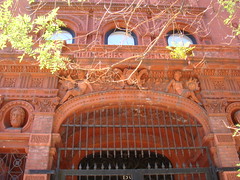 Sophie Hoeller The Deutsches Dispensary, Third Avenue and St. Marks, an enduring icon of the East Village’s history as “Little Germany.”
Sophie Hoeller The Deutsches Dispensary, Third Avenue and St. Marks, an enduring icon of the East Village’s history as “Little Germany.”Last Friday, at the start of the first weekend of Oktoberfest, we wrote about the East Village’s former notoriety as “Little Germany,” an enclave for German immigrants in the 19th century.
As the celebration of German culture comes to close this weekend, the answer to one question remains elusive: What happened to the German community in the East Village?
Some historians — and at least one reader — link Little Germany’s decline to the General Slocum disaster in 1904, when a chartered cruise boat carrying members of the St. Mark’s Evangelical Lutheran Church to a picnic, caught fire in the East River, killing more than 1,000 people, including many inhabitants of Little Germany.
A memorial of the General Slocum disaster can be found in Tompkins Square Park, where a small fountain reminds us of the Germans who lost their lives.
However, author William Grimes said that the decline was due more to the classic immigrant pattern of “succeed and disperse,” in which immigrants prospered and moved out of the immediate neighborhood. Many successful Germans moved to 86th Street, creating Yorkville, another German enclave of which little remains.
“When I moved to New York in 1980 there were still quite a few delicatessens and bakeries and German restaurants around there,” Mr. Grimes said in a phone interview, “But even since then that has disappeared and that’s simply because Germans became wealthier and moved away, and there was no longer that cohesion that you had of the first immigrant neighborhood that they created.”
Eventually Germans assimilated so well into American culture that barely anything is left, Mr. Grimes said, even though his book “Appetite City, A Culinary History of New York” includes German cuisine as a testament to its once very prominent place in the city’s culture.
Well into the mid-20th century, Americans were enthralled by entire families happily guzzling giant beers, singing, and waving forks of sauerkraut, and so German culture enjoyed enormous popularity and prestige. Beer gardens were all around the city. Among the most famous was the Atlantic Garden on Canal and Bowery with seating for 3,000 customers, a shooting range, bowling alleys, billiard tables and live bands. The beer gardens were “entire worlds in themselves” Mr. Grimes explained, adding “people were fascinated by it as a spectacle.”
German beer also permanently altered the American cultural landscape, as Germans brought lager beer to the American palate, which was previously only accustomed to English-style beer. Even today the German brew is the dominant style in America.
The corner deli with its flowers and takeout foods has its roots in Little Germany as well, as delicatessens were created by the immigrant’s insatiable appetite for wurst, spätzle and other specialties the American didn’t know.
After the two world wars and Prohibition, the popularity of German culture saw a sharp decline. After the world wars people didn’t want to associate themselves with German culture; by the 1950s even the Lüchow restaurant on 14th Street removed the umlaut from its name.
Though stores with German ancestry can still be found all over the metro area, Little Germany has practically vanished. But in the East Village, the memories live on.



